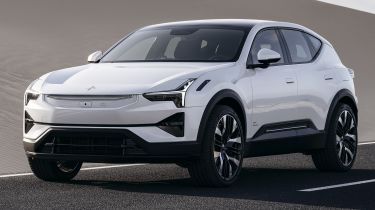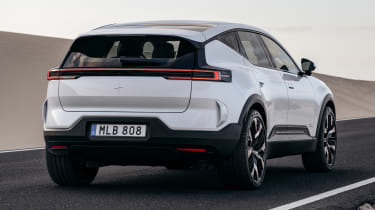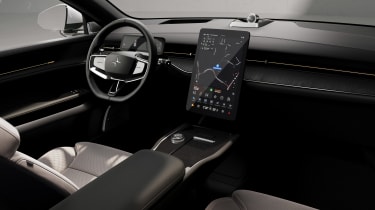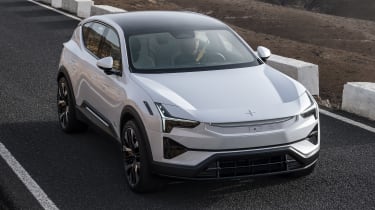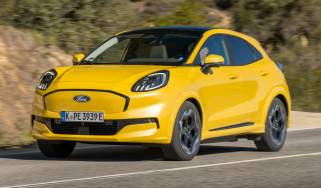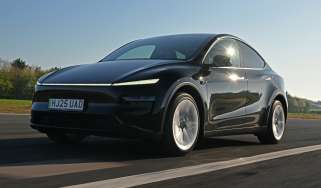All-new Polestar 3 electric SUV unveiled with 379-mile range
Sweden’s Tesla Model X and BMW iX rival is available to order now, with prices starting from £79,900
After months of drip-fed tid-bits and more than the occasional teaser image, Polestar has finally torn the covers off its aptly named third model and its first electric SUV: the all-new Polestar 3. It's available to order now through Polestar’s website, rivals include the BMW iX and Audi e-tron, plus the Lotus Eletre and Tesla Model X.
The Polestar 3 is the Swedish firm’s first bespoke EV. In fact, it’s the first car to use the brand-new SPA2 platform developed by its parent company Volvo to underpin larger electric cars, including its zero-emissions successor to the much-loved XC90, due in November.
There are two versions of the Polestar 3 available at launch; the standard Long Range model (from £79,900) with an official range of 379 miles, and a Performance Pack car with a 360-mile range. The latter costs £85,445 and can do 0-62mph in 4.7 seconds.
For reference, at exactly 4.9m long, the Polestar 3 is 53mm shorter than the current Volvo XC90, as well as being a little lower and a little narrower, but its almost three-metre-long wheelbase is nearly identical to the Volvo's. Some typical Polestar styling cues include a full-width ‘light blade’, frameless mirrors and flush door handles, plus an evolution of the brand’s signature ‘Thor’s Hammer’ headlights.
However, the Polestar 3 does feature some unique elements, such as an ‘S-Duct’ at the front to feed air over the bonnet and aerodynamic fins on the rear bumper. And unlike the boxier BMW iX, the Polestar’s roofline slopes gently towards the rear as it approaches a large spoiler, also designed to improve efficiency.
Polestar 3 Range, performance, battery and charging
Both the Long Range and Performance Pack models feature a 111kWh (107kWh usable) battery, offering a range of 379 and 360 miles respectively. That puts it in direct competition with the BMW iX, which in its longest-range form can cover 380 miles fully charged. The latest Tesla Model X Long Range has a range of just under 350 miles.
It’s the same story with performance; at launch the Polestar 3 is only offered with a rear-biased, dual-motor powertrain for all-wheel-drive and 482bhp in the Long Range version, good for 0-62mph in five seconds flat. The Performance Pack bumps power up to 510bhp and 910Nm of torque, simultaneously slashing the sprint from a standstill to 4.7 seconds. Both cars have a 130mph maximum speed.
Additional features include torque vectoring, adjustable regenerative braking, adaptive air suspension and active dampers as standard. Polestar says the suspension and dampers on its “electric performance SUV” can make adjustments based on road conditions once every two milliseconds.
Thanks to a maximum charging speed of 250kW, a 10-80% top-up takes just 30 minutes – enough to cover more than 300 miles in the Polestar 3 Long Range. A full charge from an 11kW wallbox will take 11 hours, but expect a normal 7.4kW wallbox to do the same job in around 15 hours.
Interior, technology and practicality
The Polestar 3’s interior is both very similar and very different to the brand’s previous offerings. The cabin is still a very minimalist affair, with the only physical control being a volume dial on the centre console – everything else is controlled though the 14.5-inch central touchscreen. It’ll run an evolution of the Polestar’s Android Automotive infotainment system, with over-the-air update capabilities and Google maps among other services built-in.
Other standard kit includes the nine-inch digital driver’s display behind the steering wheel, a 360-degree parking camera and a powered tailgate, plus a heat pump to more efficiently warm the cabin and pre-condition the battery before charging. That’s before the vast array of driver assistance features, including adaptive cruise control, two on-board cameras for detecting driver fatigue, and a radar system which can scan for children or pets left inside the car and adjust the climate settings accordingly.
The cabin itself is finished with a variety of sustainable materials such as MicroTech fabrics, fully-traceable wool and animal welfare-certified leather, complimented by a panoramic glass roof and ambient lighting. The boot measures 484 litres, which is just 16 less than the BMW iX offers, but unlike its chief rival, there’s a 32-litre frunk in the Polestar’s nose. If you need more space, the rear seats fold down giving you 1,411 litres to play with.
All launch models come with Polestar’s Pilot Pack and Plus Pack as standard, with the latter adding luxuries like cabin air filtration, heated rear seats, a 25-speaker Bowers & Wilkins stereo and even soft-closing doors. Meanwhile, the Pilot Pack includes goodies like a head-up display, parking assist and adds lane centering to the adaptive cruise control.
In total, there are five radar modules, five external cameras and twelve ultrasonic sensors to dotted the large electric SUV to feed data to its safety systems, which can be expanded with the optional “Pilot Pack with LiDAR” that’ll become available towards the end of 2023. This adds three extra cameras and four additional ultrasonic sensors to scan the environment in real time, supporting the possibility of autonomous driving further down the line.
Prices and equipment
For the first year, all Polestar 3s will come with the Pilot Pack and Plus Pack we mentioned above, on top of all the standard kit like the 21-inch rims, panoramic roof, LED lights, 14.5-inch touchscreen, nine-inch instrumental panel and all-wheel-drive powertrain. Prices for the entry-level Polestar 3 Long Range start from £79,900.
You’ll have to pay at least £85,445 if you want the Performance Pack, which boosts the power from 482bhp to 510bhp, and also adds tweaks to the chassis and suspension, plus visual differences carried over from the Polestar 2 like larger 22-inch alloy wheels, gold-coloured valve caps, and gold seatbelts.
The options lists for the Polestar 3 is very slim, with just Nappa leather interior, metallic paint, acoustic laminated glass, upgraded LED headlights and an electric folding tow bar available, though non-Performance Pack cars can optioned with a set of 22-inch rims, too.
Order books for the Polestar 3 are now open, but first deliveries are not due to begin until late 2023. The large electric SUV will be manufactured both in China and the US, alongside Volvos at the company’s Ridgeville plant in South Carolina.
Future Polestar EV plans
In 2023, not only will the Swedish brand give its hugely popular Polestar 2 saloon a mid-life facelift, it’s set to launch a sporty coupe-SUV called the Polestar 4. It’s set to rival the Tesla Model Y and forthcoming electric Porsche Macan among others, but few details have been released so far. The Polestar 5 is then set to arrive in 2024, serving as Polestar’s answer to the luxury electric saloons like the Lucid Air, Tesla Model S and Mercedes EQS.
Sometime after that, most likely in 2026, the drop-top Polestar 6 will go into production. The road-going version of the stunning Polestar O2 concept will use the same bonded aluminium platform and 872bhp dual-motor powertrain as the Polestar 5 currently being developed in the UK. No other details have been revealed, but the first 500 examples of the Swedish Tesla Roadster rival are spoken for already.

